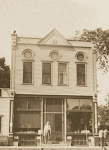In the 1890’s the township started graveling roads. The town purchased several gravel pits, and the graveling was done by men who had been assessed one or more days of work on the road.
An interesting entry from the annual meeting of 1898 reads as follows:
“on motion it was resolved that no one whatsoever shall be allowed to enter upon the public highway with their plows for the purpose of using said highway to scour their plows, nor for any other purpose, both before and after said highway has been graded”.
An entry from the annual meeting of March 10, 1914 reads, “on motion it was resolved to pay 20 cents an hour for man and 20 cents an hour for a team of horses or mules for road labor.”end
Tuesday, May 29, 2007
Monday, May 28, 2007
Tell Us Your Story
The committee is looking for your story to publish in our book. Our members are doing research - but we need your help to get the "good stuff" that only you community members know about. Our research is limited to what was printed in local newspapers and some documented histories of families and organizations. A lot of you folks who live in other areas grew up here and have many good memories and stories of happenings that did not make the local paper!
Please take a moment and jot down your accounting and send it to our Google mail box at norseland150@gmail.com or make a comment on this blog and we will use your story in our history book. Thanks for your help! And remember, History Matters! end
Please take a moment and jot down your accounting and send it to our Google mail box at norseland150@gmail.com or make a comment on this blog and we will use your story in our history book. Thanks for your help! And remember, History Matters! end
Wednesday, May 23, 2007
LEFSE BY MARY
Ole and Mary Olmanson were Norseland residents. Ole-1876-1968; Mary 1881-1964. Mary was famous for baking Lefse. In 1959, she was featured in a Mankato Free Press article and was quoted as follows: "I have made about 32,000 lefse in my lifetime!"
That's a lot of lefse! Ole said that the secret was to wait for the potato, shortening, sugar, and salt mixture to cool before adding the flour. Read more about lefse in our Norseland History book, entitled "Norseland: Where the Big Woods Meets the Prairie". Remember, History Matters! end
That's a lot of lefse! Ole said that the secret was to wait for the potato, shortening, sugar, and salt mixture to cool before adding the flour. Read more about lefse in our Norseland History book, entitled "Norseland: Where the Big Woods Meets the Prairie". Remember, History Matters! end
Tuesday, May 22, 2007
Wednesday, May 16, 2007
Grasshopper Plague
The pioneers in the Norseland Area were attacked by grasshoppers during the years of 1874-1877. The worst year was 1875. During that year, Nicollet County reported 5,000 acres of damage. During this plague, the state of Minnesota allowed counties to offer a bounty on all grasshoppers caught and destroyed. The price paid by the Nicollet County Auditor was from three to ten cents a bushel. Read a full account of the plague in our coming book. Find out which Nicollet County farmer caught 633 bushels of them. Learn about the cottage industry that developed as local entrepreneurs built "hopperdozers" to trap the locusts. Remember, "History Matters!" end
Friday, May 4, 2007
IS IT MURDER?
IS IT MURDER? That was the headline of the St. Peter Tribune in 1889.
In 1889, the possibility of murder shocked the community. Mr. and Mrs. Svenke Torgerson were found dead in the burned-out remains of their home. Svenke Torgerson was 73 years of age and his wife, Bergit, was 69 years old. They had been among the earliest Norwegian settlers in New Sweden Township having arrived in 1855. Their farm-site was established in the northern part of New Sweden Township. The Torgersons were charter members of Norseland Lutheran Church and, eight years prior to their death, also were founding members of Norwegian Grove Lutheran Church.
The suspicion of their murder arose because, as the St. Peter Tribune points out, “some very tough looking hunters” were seen in the area the previous day. Some “tramps” were seen traveling toward Nicollet the afternoon after their death. Also, a wagon was heard speeding through the neighborhood between 1:00 and 2:00 o’clock of that morning.
Read the rest of the story in our book to be published in 2008. end
In 1889, the possibility of murder shocked the community. Mr. and Mrs. Svenke Torgerson were found dead in the burned-out remains of their home. Svenke Torgerson was 73 years of age and his wife, Bergit, was 69 years old. They had been among the earliest Norwegian settlers in New Sweden Township having arrived in 1855. Their farm-site was established in the northern part of New Sweden Township. The Torgersons were charter members of Norseland Lutheran Church and, eight years prior to their death, also were founding members of Norwegian Grove Lutheran Church.
The suspicion of their murder arose because, as the St. Peter Tribune points out, “some very tough looking hunters” were seen in the area the previous day. Some “tramps” were seen traveling toward Nicollet the afternoon after their death. Also, a wagon was heard speeding through the neighborhood between 1:00 and 2:00 o’clock of that morning.
Read the rest of the story in our book to be published in 2008. end
Subscribe to:
Posts (Atom)




